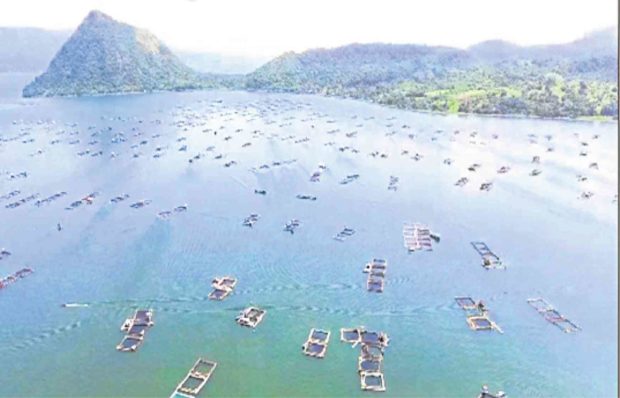
TILAPIA CULTURE Growing tilapia in fish cages in Taal Lake is a multimillion-peso industry in Batangas province. —PHOTO COURTESY OF TAAL VOLCANO PROTECTED LANDSCAPE OFFICE
The local government of Agoncillo town in Batangas province will distribute tilapia fingerlings to local cage operators affected by the recent fishkill in Taal Lake.
The incidence of “fish mortality,” a term preferred by local officials in referring to a smaller area where fish turn belly up, occurred at Barangay Subic Ilaya, said Agoncillo Mayor Daniel Reyes.
He said 105 cages, out of 1,555 operating in the town, were affected, with about P5 million worth of mature and juvenile tilapia killed in a phenomenon called “sulfur upwelling.”
Natural phenomenon
Reyes, in a telephone interview on Monday, said the fishkill occurred during the wee hours of Oct. 31.
Quoting reports from the Bureau of Fisheries and Aquatic Resources (BFAR), Jasmin Andaya, assistant protected area superintendent of Taal Volcano Protected Landscape, said the mortality was caused by sulfur upwelling.
“It’s a natural phenomenon that has something to do with the change in wind direction or by the ‘amihan’ (northeast monsoon) usually [from] December to January,” Andaya said in a separate telephone interview.
Color change
According to the BFAR, sulfur upwelling happens when toxic chemicals like hydrogen sulfide and ammonia rise to the water’s surface, thus reducing dissolved oxygen.
Marine animals require a certain level of dissolved oxygen in the water to survive, it said.
It happened in the past, in 2011 and 2014, in other portions of the lake and had cost millions of pesos worth of losses to fish cage owners, prompting the BFAR to issue advisories usually toward the end of the year.
What fish cage operators usually do is either harvest the stock or move cages to safer areas in the lake, Andaya said.
“But since it happened at night, [operators] did not see [the change in water color] and had no time to tow the cages,” she added.
Andaya said local officials had finished clearing the lake of dead fish on Sunday.
Tilapia cage farming is a multimillion-peso industry in Taal Lake, the country’s third largest freshwater body.
At least 5,000 fish cages operate in the lakeshore towns of Talisay, Laurel, Agoncillo, San Nicolas, Cuenca and Mataas na Kahoy in Batangas, government records showed. —MARICAR CINCO